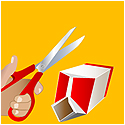
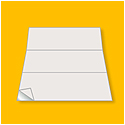
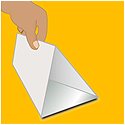
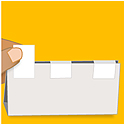
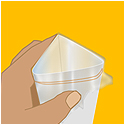
Experiment Category:
Objective:
What You Need:
- 1 sheet of thick paper or a clean quart-size milk or juice carton
- Scissors
- Mirrored contact paper, which can be bought in a roll at the hardware store; or mylar
- Masking tape
- Plastic wrap
- 2 Rubber bands
- Little pieces of ribbon or tissue paper in different colors
- Waxed paper or tracing paper
To Do and Observe:
1. Start with a rectangle of stiff paper. You can make one by cutting open and flattening a quart-sized carton.
2. Use your rectangle as a guide to cut out a same-sized rectangle of mirrored contact paper. Peel of the backing and cover the thick paper rectangle with the contact paper.
3. Make two folds in the rectangle and bend it into a triangular tube shape, with the shiny side forming the inside of the tube.
4. Tape the ends together.
5. Stretch a piece of plastic wrap over one end of the tube and fasten it in place with a rubber band.
6. Cut you ribbons or tissue paper into small pieces and put them on top of the plastic-wrapped end of the tube.
7. Carefully place a piece of waxed paper over the same end, and fasten it with a rubber band.
8. Look through the open end of your tube. Shake and twist your tube to move the colorful pieces. How does it change the pattern you see?
What's Going On:
Kaleidoscopes have been popular toys in America for more than a hundred years. The word kaleidoscope comes from the Greek words “kal(os)” which means beautiful, “eido(s)” which means shape, and “scope” which means viewing. Designers have used this toy to find new patterns for carpets, wallpaper, and other various fabrics.
Kaleidoscopes are usually in the form of a round tube with a peephole at one end. When you look through the peephole and rotate the tube, you see an ever-changing variety of colored patterns. The secret behind these incredible designs is mirrors and their reflections.
Light usually travels in a straight line, but when it encounters an object it can change direction. The inside of a kaleidoscope is mirrored. Light bounces off a mirror like a ball bounces off of the floor. Light passes through the waxed paper end of the kaleidoscope and bounces off of each of the of the three mirrored surfaces of the tube. Through the kaleidoscope you can see an image of the colorful objects repeated three times. As you turn the kaleidoscope around you can see many beautiful patterns that are formed as the objects shift and the light is reflected. The reflections from the mirrors make symmetrical patterns. Symmetrical patterns are patterns that look the same on both sides of an imaginary line or the line of the mirror.
Parent/Teacher Tips:
For Younger Participants
Have the participants place marbles or beads in a Ziploc bag and tape that bag over one open end of the tube. Have them move a few beads at a time to see the patterns that they can make. They can also use stickers and make observations about ways the reflections looks different than the original image.
For Older Participants
Have the participants try bending the tube more than twice, to create tubes with more than three reflecting surfaces. How does this affect the image that you see?

Comments
like
Good Parent/Teacher Tips